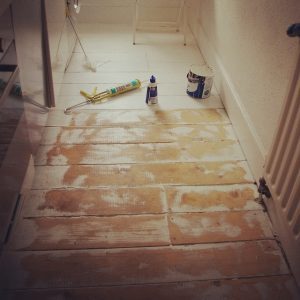What is the R value of plywood? In this article, we take an in-depth look at R values for common plywood products used in construction, as well as R values for sheetrock and OSB.
What is R Value?
R-value is a term that refers to a material’s thermal resistance, or its ability to provide insulation from cold or heat. The higher a material’s R-value, the better its insulation properties are. Manufacturers determine R-value by measuring heat flow in tightly controlled laboratory settings. This way, consumers are able to make sound decisions about the building materials they choose to use.

You probably know that heat moves easily from one place to another, so long as nothing is blocking its path. Inside your home, heat is transferred from warm spaces to cooler ones. If you leave a door open or a window cracked on a freezing cold day, you’ll notice just how quickly this transfer takes place!
Heat can also travel through solid materials. The higher a solid material’s R-value, the slower this transfer will occur. Keep in mind that your heating system must use energy to replace heat that’s lost during the winter, and that your cooling system has to compensate for heat that’s gained during the summer. With higher R-values come better energy savings and greater comfort.
While it’s common to worry about R-values in areas where cold weather prevails, R-value matters in hot areas, too. Just as warmth can travel from the inside of a home to the outdoors when the weather is freezing, heat from outside can penetrate a building’s interior in hot weather. This can lead to increased cooling costs, so it’s a good idea to keep R-values in mind, no matter what the climate.
Plywood R Value
Is plywood good insulation? The short answer is “no,” at least, not compared with products designed to provide insulation from cold and heat. Even so, plywood products do offer minimal R value, along with structural benefits. Most modern structures contain some plywood or OSB, so knowing these R values can help you calculate the R value of walls, floors, and attic spaces in your home.
In general, one inch of solid wood is considered to have an R value of 1.
The general plywood R value per inch is 1.25.
- 1/4” Plywood R-Value = 0.31
- 3/8” Plywood R-Value = 0.47
- 15/32” Plywood R-Value = 0.59
- 1/2″ Plywood R-Value = 0.63
- 19/32” Plywood R-Value = 0.74
- 5/8” Plywood R-Value = 0.77
- 23/32” Plywood R-Value = 0.90
- 3/4″ Plywood R-Value = 0.94
- 7/8” Plywood R-Value = 1.09
- 1” Plywood R-Value = 1.25
- 1-1/18” Plywood R-Value = 1.41
The general R-value of particle board underlayment is 1.31 per inch.
5/8” Particle Board underlayment R-Value = 0.82
General R-values for oriented strand board (OSB) are listed below:
- 3/8” OSB R-Value = 0.45
- 7/16” OSB R-Value = 0.51
- 1/2″ OSB R-Value = 0.74
- 3/4″ OSB R-Value = 0.91
R Value of Plywood vs. Sheetrock
When comparing the r value of plywood vs. sheetrock, it’s important to take thickness into consideration. 1/2″ gypsum board drywall has an R value of 0.45, which is 0.18 lower than 1/2″ plywood.
How is R-Value Calculated?
To compute R-value, use the formula (hour x degrees F x square feet)/BTU.
The R-value of plywood, insulation, sheetrock, siding, and even paint can go into a total R-value calculation for a single wall. The simplest way to determine a wall’s R value is to add up the R-values for each of its components. For example, a wall with sheathing, siding, drywall, and 3-1/2” R-11 fiberglass insulation probably has an R-value of approximately 14.
There’s more to the picture, though. To calculate R-value for a home, you need to know the R-value for each wall, as well as for the floor and attic. Because of the presence of studs in the walls, windows, doors, and small areas such as outlets where heat transfer occurs at a faster pace, most people arrive at an estimate rather than calculating R value precisely.
Different building materials have different R values. Concrete, glass, sheetrock, various types of insulation, OSB, plywood, and siding are often factored in when calculating R value of a house. Additional considerations include air infiltration and air escape. While it is possible to get a general idea of your home’s R-value, you may want to consider an energy audit that takes all points of conductive, convective, and radiant heat transfer into consideration.
Most of us never worry about calculating R values for an entire structure. In the real world, R-values for plywood and other building materials make it easier to make energy-efficient choices, i.e. R13 insulation vs. R19 insulation.
Some materials lose R value with age, compression, moisture accumulation, and other variables. If your home is older and the insulation is old, your R-value calculations may be inaccurate, and you may find that new insulation increases energy efficiency.




